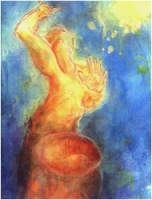Difference between revisions of "Rhythm"
m (Text replacement - "http://" to "https://") |
|||
| Line 3: | Line 3: | ||
==Etymology== | ==Etymology== | ||
Middle French & [[Latin]]; Middle French rhythme, from Latin rhythmus, from [[Greek]] rhythmos, probably from rhein to [[flow]] | Middle French & [[Latin]]; Middle French rhythme, from Latin rhythmus, from [[Greek]] rhythmos, probably from rhein to [[flow]] | ||
| − | *Date: [ | + | *Date: [https://www.wikipedia.org/wiki/16th_Century 1560] |
==Definitions== | ==Definitions== | ||
*1 a : an ordered recurrent alternation of strong and weak elements in the [[flow]] of [[sound]] and [[silence]] in [[speech]] | *1 a : an ordered recurrent alternation of strong and weak elements in the [[flow]] of [[sound]] and [[silence]] in [[speech]] | ||
| Line 19: | Line 19: | ||
A rhythmic [[unit]] is a durational [[pattern]] which occupies a period of time equivalent to a pulse or pulses on an underlying metric level, as [[opposed]] to a rhythmic [[gesture]] which does not (DeLone et al. (Eds.), 1975 | A rhythmic [[unit]] is a durational [[pattern]] which occupies a period of time equivalent to a pulse or pulses on an underlying metric level, as [[opposed]] to a rhythmic [[gesture]] which does not (DeLone et al. (Eds.), 1975 | ||
==Origins of human appreciation of rhythm== | ==Origins of human appreciation of rhythm== | ||
| − | In his series How Music Works, [ | + | In his series How Music Works, [https://en.wikipedia.org/wiki/Howard_Goodall Howard Goodall] presents [[theories]] that rhythm recalls how we walk and the heartbeat we heard in the [[womb]]. More likely is that a simple pulse or di-dah beat recalls the footsteps of another [[person]]. Our sympathetic urge to [[dance]] is designed to boost our [[energy]] levels in order to cope with someone, or some animal chasing us – a fight or flight response. From a less darwinist [[perspective]], perceiving rhythm is the ability to [[master]] the otherwise [[invisible]] [[dimension]], time. Rhythm is possibly also rooted in courtship [[ritual]]. |
| − | Neurologist [ | + | Neurologist [https://en.wikipedia.org/wiki/Oliver_Sacks Oliver Sacks] posits that [[human]] affinity for rhythm is fundamental, so much that a [[person]]'s sense of rhythm cannot be lost in the way that [[music]] and [[language]] can (e.g. by stroke). In addition, he states that chimpanzees and other animals show no similar [[appreciation]] for rhythm.[https://en.wikipedia.org/wiki/Rhythm] |
[[Category: Linguistics]] | [[Category: Linguistics]] | ||
[[Category: Music]] | [[Category: Music]] | ||
Latest revision as of 02:32, 13 December 2020
Etymology
Middle French & Latin; Middle French rhythme, from Latin rhythmus, from Greek rhythmos, probably from rhein to flow
- Date: 1560
Definitions
- 1 a : an ordered recurrent alternation of strong and weak elements in the flow of sound and silence in speech
- b : a particular example or form of rhythm <iambic rhythm>
- 2 a : the aspect of music comprising all the elements (as accent, meter, and tempo) that relate to forward movement
- b : a characteristic rhythmic pattern <rumba rhythm>
- c : the group of instruments in a band supplying the rhythm —called also rhythm section
- 3 a : movement, fluctuation, or variation marked by the regular recurrence or natural flow of related elements <the rhythms of country life>
- 4 : a regularly recurrent quantitative change in a variable biological process <a circadian rhythm>
- 5 : the effect created by the elements in a play, movie, or novel that relate to the temporal development of the action
Description
The study of rhythm, stress, and pitch in speech is called prosody; it is a topic in linguistics. Narmour (1980, p. 147–53) describes three categories of prosodic rules which create rhythmic successions which are additive (same duration repeated), cumulative (short-long), or countercumulative (long-short). Cumulation is associated with closure or relaxation, countercumulation with openness or tension, while additive rhythms are open-ended and repetitive. Richard Middleton points out this method cannot account for syncopation and suggests the concept of transformation.
A rhythmic unit is a durational pattern which occupies a period of time equivalent to a pulse or pulses on an underlying metric level, as opposed to a rhythmic gesture which does not (DeLone et al. (Eds.), 1975
Origins of human appreciation of rhythm
In his series How Music Works, Howard Goodall presents theories that rhythm recalls how we walk and the heartbeat we heard in the womb. More likely is that a simple pulse or di-dah beat recalls the footsteps of another person. Our sympathetic urge to dance is designed to boost our energy levels in order to cope with someone, or some animal chasing us – a fight or flight response. From a less darwinist perspective, perceiving rhythm is the ability to master the otherwise invisible dimension, time. Rhythm is possibly also rooted in courtship ritual.
Neurologist Oliver Sacks posits that human affinity for rhythm is fundamental, so much that a person's sense of rhythm cannot be lost in the way that music and language can (e.g. by stroke). In addition, he states that chimpanzees and other animals show no similar appreciation for rhythm.[1]
